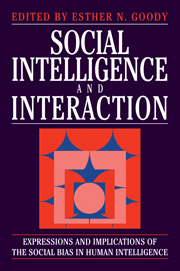 Social Intelligence and Interaction
Social Intelligence and Interaction Published online by Cambridge University Press: 09 January 2010
In this chapter I shall consider some relationships between sequential patterns or organizations in talk-in-interaction, notably in conversation, and that aspect of social intelligence which Goody has termed ‘anticipatory interactive planning’ (hereafter AIP). Social intelligence consists, in part anyway, of cognitive models of action which might underlie the production and interpretation of ‘meaningful’ communicative behaviour among social beings (humans, and possibly some primates; see Byrne, Chapter 1, this volume). AIP highlights the reciprocity of communication in social relations, incorporating as it does the mental representation of alter's responses to ego's actions (Goody, Introduction to this volume). Goody is thereby suggesting that AIP concerns the possibility that, via their cognitive models of action, interactants have ways of predicting that if they make a given verbal ‘move’ (and from now on I shall refer exclusively to those actions which are verbal), this will engender or facilitate a subsequent verbal action by either themselves or their recipients. The predictability of some contingent subsequent action(s) is part of ‘mentally modelling’ the likely behaviour/responses of their cointeractants, which hence underpins the strategic nature of selecting a current action.
The ability to anticipate subsequent verbal actions, performed in turns at talk, and to select or design a current action (turn) accordingly, would seem to rest on the cognitive representation of sequences of actions. I mean by ‘sequences of actions’ the discernible shapes, patterns, organizations or regularities which may be associated with, or which may be the products of, the progressivity of participants' decisions about ‘what to say next’ in response to what was just said.
To save this book to your Kindle, first ensure no-reply@cambridge.org is added to your Approved Personal Document E-mail List under your Personal Document Settings on the Manage Your Content and Devices page of your Amazon account. Then enter the ‘name’ part of your Kindle email address below. Find out more about saving to your Kindle.
Note you can select to save to either the @free.kindle.com or @kindle.com variations. ‘@free.kindle.com’ emails are free but can only be saved to your device when it is connected to wi-fi. ‘@kindle.com’ emails can be delivered even when you are not connected to wi-fi, but note that service fees apply.
Find out more about the Kindle Personal Document Service.
To save content items to your account, please confirm that you agree to abide by our usage policies. If this is the first time you use this feature, you will be asked to authorise Cambridge Core to connect with your account. Find out more about saving content to Dropbox.
To save content items to your account, please confirm that you agree to abide by our usage policies. If this is the first time you use this feature, you will be asked to authorise Cambridge Core to connect with your account. Find out more about saving content to Google Drive.